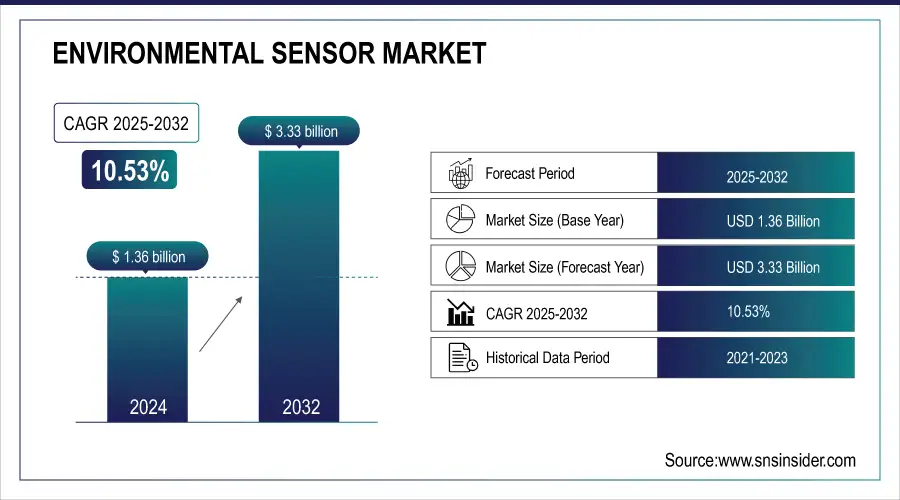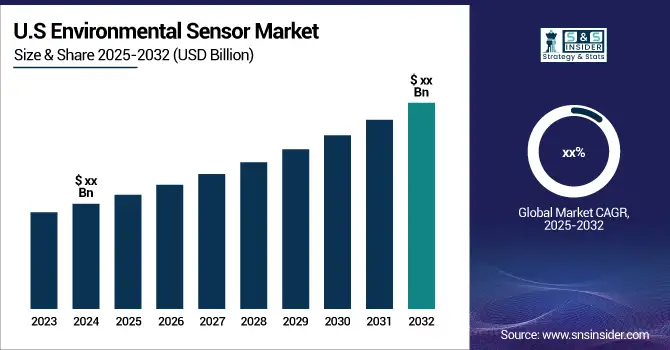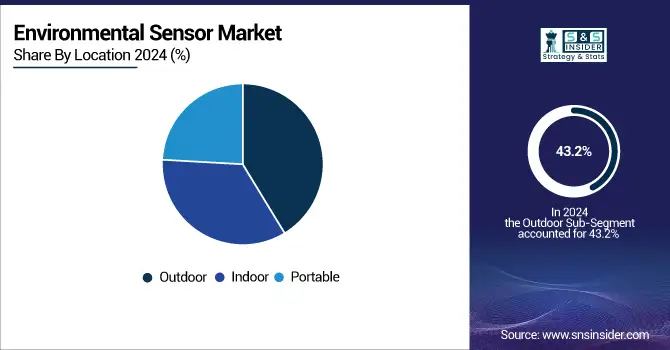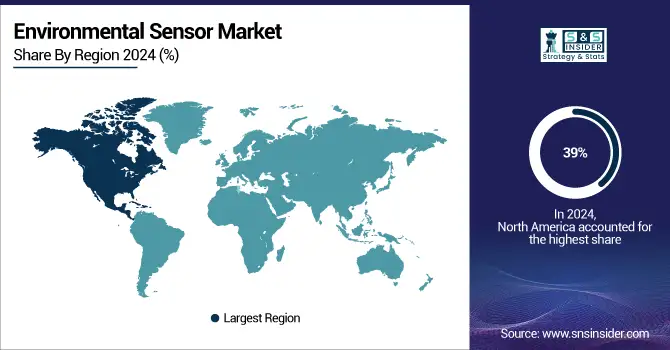Environmental Sensor Market Size Analysis:
The Environmental Sensors Market was valued at USD 1.36 billion in 2025E and is expected to reach USD 3.33 billion by 2033, growing at a CAGR of 10.53% over the forecast period 2026-2033.
The Environmental Sensors Market is growing significantly due to rising awareness and demand for sustainable solutions. With increasing awareness about climate change, air pollution, and water pollution, environmental sensors have been extensively used for monitoring and regulating environmental conditions. Strict environmental regulations are being enforced by governments and regulatory bodies, increasing the demand for accurate and real-time monitoring of air quality, water quality, temperature, and other environmental parameters. This has led to an enthusiastic market for environmental sensors in smart cities, healthcare, and industrial applications where the accuracy of data is critical for safety and efficiency.
Environmental Sensor Market Size and Forecast:
-
Market Size in 2025E: USD 1.36 Billion
-
Market Size by 2033: USD 3.33 Billion
-
CAGR: 10.53% from 2026 to 2033
-
Base Year: 2025
-
Forecast Period: 2026–2033
-
Historical Data: 2022–2024

Get More Information on Environmental Sensor Market - Request Sample Report
The U.S. Environmental Sensors market size was valued at an estimated USD 0.52 billion in 2025 and is projected to reach USD 1.30 billion by 2033, growing at a CAGR of 9.4% over the forecast period 2026–2033. Market growth is driven by increasing environmental monitoring requirements, rising concerns over air and water pollution, and stricter regulatory standards for environmental protection. Growing adoption of environmental sensors across applications such as air quality monitoring, water quality management, industrial emission control, and smart city infrastructure is accelerating market expansion. Additionally, advancements in sensor technologies, integration with IoT and cloud platforms, and increasing government and private sector investments further support the steady growth outlook of the U.S. environmental sensors market during the forecast period.

Environmental Sensor Market Drivers:
-
Industrial Automation and Sustainability Drive Demand for Advanced Environmental Sensors in Multiple Sectors
Driving forces for stimulating demand for the Environmental Sensors Market include an increasing adoption of industrial automation and smart manufacturing processes. To monitor environmental parameters in real-time in multiple industries, advanced environmental sensors are being utilized. That is important to maximize production capabilities, ensure security and safety, and meet environmental compliance. In industrial environments, smart sensors play a key role in predictive maintenance, minimizing downtime, and enhancing operational effectiveness. Moreover, the shift of industries towards sustainable and green technologies is also pushing the demand for environmental sensors to monitor emissions and waste products thus, propelling the market. We anticipate that industrial automation, especially in manufacturing, automotive, and energy sectors, will drive the need for advanced environmental sensors that deliver accurate real-time data for enhancing operational efficiency and sustainability. By 2024, more than 50% of industrial plants will employ AI-powered sensors to achieve a 40% reduction in downtime and 20-30% savings in maintenance costs. Sustainable manufacturing came in at 7.5% growth with 60% of smart sensor applications in the form of predictive maintenance in the manufacturing, automotive, and energy sectors. 40% of industrial facilities around the world have incorporated environmental sensors for real-time data on emissions and waste. Moreover, the new plants that introduced smart sensors for energy consumption and waste reduction accounted for 15% of them.
-
Renewable Energy Growth Drives Demand for Environmental Sensors to Optimize Performance and Sustainability
The rise of renewable energy is also an important factor stimulating the Environmental Sensors Market. As the world transitions to cleaner energy resources in the form of solar and wind power, so does the need to monitor the environmental factors impacting power generation. Data collection devices for environmental sensors help optimize the performance of renewable energy systems by providing data on weather patterns, temperature variations, and air quality. As a case in point, for solar energy, environmental sensors can monitor sunlight and cloud coverage to help identify optimal solar panel setups and usage. Just like any industry, wind turbines depend on their environmental sensors for accurate readings of wind speed, wind direction, and the other key environmental characteristics that drive energy production. Demand for environmental sensors is expected to increase further given the growing focus on renewable energy infrastructure and sustainability, which makes it an important enabler in the worldwide move towards greener energy alternatives. With the total global deployment of solar PV technology expected to surpass USD 500 billion in 2024, the need to monitor sunlight and cloud coverage with sensors has driven this trend. More than 85% of wind farms will have new environmental monitoring sensors to measure wind speed and wind direction, and more than 40% of wind turbines will adopt IoT-enabled sensors for predictive maintenance and operational performance. Along with this, it is estimated that environmental sensors will boost 18% in renewable energy systems enabling better operational efficiency and energy output.
Environmental Sensor Market Restrain:
-
Challenges in Environmental Sensors Market Include Data Accuracy Calibration Issues and Lack of Standardization
Data accuracy & data reliability issues are one of the major challenges in the Environmental Sensors Market. Environmental sensors are often exposed to varied and uncontrolled environments and therefore constant and accurate readings are difficult to maintain. Extreme temperatures, high humidity conditions, etc. Environmental conditions can jeopardize the accuracy of the sensor reading which in turn corrupts the data and results. Calibrating their sensors and achieving long-term accuracy over large areas continues to be a major obstacle for manufacturers. Another important restraint includes the non-availability of standardization among environmental sensors. The need for different specifications of sensors in various industries, regions, and applications led to a fragmented market. This fragmentation creates high complexity for manufacturers to develop sensors that would work together across different platforms and systems since there are no universal standards in place. The lack of such interoperability could impede mass adoption, most notably in areas such as smart cities and IoT-enabled environments.
Environmental Sensor Market Segmentation Analysis:
By Location, Outdoor Sensors Lead with Strong Demand in Public Monitoring
The outdoor environment sensors segment held the largest share of 43.2% in 2025 owing to the rising demand for real-time monitoring of environment-related parameters in open spaces. They are primarily used for air quality monitoring, weather forecasting, and pollution control in smart cities and industrial applications. As climate change concerns and pressure over urban pollution and the desire for environmental sustainability have increased, governments, municipalities, and organizations have been increasingly investing in outdoor sensor networks to monitor and address these issues. Demand for high-quality, near-real-time data for the formulation and regulation of environmental policies has been a significant factor driving the market.
Portable environmental sensors are expected to be the fastest-growing segment by CAGR from 2026-2033, owing to their versatility, mobility, and ease of using portable environmental sensors. These sensors enable users to track environmental conditions in hard-to-reach or remote areas where fixed sensors cannot be deployed. Applications include growth in fields like agriculture, health, and industrial safety that require point environment data acquisition. The Portable Sensors Market is anticipated to grow at a rapid pace, incited by the ability of the industries to adapt to the concept of personalized and dynamic monitoring solutions, advancements in sensor technology, and the rising trend of IoT devices. Portable sensors also prove to be significant in mobile applications where rapid and localized environmental assessments are necessary due to their great flexibility and convenience.

By Type, Temperature Sensors Dominate and Expected to Grow Fastest
In 2025, temperature sensors held a dominant market share of 28.8% and are expected to witness the fastest CAGR during the forecast period of 2026-2033. This is because they are widely used for industrial processes, climate control systems, and environmental monitoring. In a broad array of industries manufacturing, healthcare, agriculture, and energy temperature is one of the most essential parameters for systematic functioning, safety, and product quality. Real-time monitoring and control of temperature is crucial to reduce risk, ensure compliance, and improve productivity therefore, temperature sensors are in high demand. Additionally, the increasing shift towards IoT and smart systems is also expected to push the temperature sensor market further up. With the increased adoption of automation and smart technologies across the sectors, the task of temperature monitoring now plays a significant role, both in terms of energy consumption as well as optimization of HVAC systems that can further enhance indoor environmental quality. The robustness of these components and growing precision, affordability, and simplicity of integration in thermometers significantly spur adoption over the forecast period, thus holding promising growth prospects in the coming years.
By Application, Smart Cities Lead While Smart Homes Expand Rapidly
In 2025, Smart City applications accounted for 41.5% of the Environmental Sensors Market on a growth based on the surging investments in urban infrastructure intending to make cities smarter, sustainable, robust & convenient to live. With the rise of environmental challenges, including air pollution, waste management, and energy consumption burden growing cities, environmental sensors are critical tools for urban monitoring and management. Air quality, temperature, noise level, and other data are collected through the sensors, allowing city officials to learn about the optimization of urban operations and functions, public health, and quality of life. The growing advancement for creating smart cities with various connected systems has led to this space being the market leader.
Smart Home Automation is estimated to expand with a rapid growth rate throughout 2026-2033, due to the enhancing adoption by homeowners for convenience, energy efficiency, and comfort-based technologies. Smart home automation allows environmental sensors to monitor indoor air quality, temperature, humidity, energy usage, etc. As more and more consumer IoT devices with smart voice commands come along, customers have been looking for solutions to tailor their homes to their preferences. Adoption of such trends along with the rising awareness among consumers regarding sustainability is expected to propel the demand for environmental sensors rapidly in smart homes and it is estimated to be the fastest-growing application over the years.
By Vertical, Government Sector Leads While Healthcare Gains Momentum
In 2025, the Government sector dominated the Environmental Sensors Market and held a share of 24.5%. Increased demand for environmental monitoring due to regulatory compliance and public health and safety concerns associated with industrial plants, as well as expanding initiatives for sustainable development, have all contributed to the growth of the Government sector in terms of revenue generation. Around the world, governments are implementing smart city projects and environmental policies that depend on continuous data collection about air quality, water quality, temperature, and other environmental metrics. Environmental sensors play a crucial role in these initiatives as they help cities and governments monitor pollution, track climate change, and regulate the environment. Moreover, it will continue to strengthen the position of government investments in environmental monitoring systems, due to the pursuit of a decrease in carbon footprints and infrastructure upgrades.
The Healthcare sector is likely to grow with the highest CAGR throughout the forecast period from 2026-2033, due to the surging demand for accurate and real-time monitoring of environmental conditions in healthcare settings. Patient health, comfort, and recovery are largely affected by environmental factors like humidity, air quality, and temperature. Hospitals and clinics are using environmental sensors to guarantee decent patient conditions, contain infection, and make healthcare facilities more energy-efficient. In addition, increasing applications of portable environmental sensors for real-time personal health conditions monitoring due to growing demand for wearable devices and telemedicine is further contributing to the market growth. Thus, as the health care industry starts making plenty of efforts in delivering a strong focus on the patient care process and working on maintaining the health care facility, the role of environmental sensors in healthy environments will drive better health outcomes.
North America Dominates the Environmental Sensor Market in 2025
In 2025, North America commands an estimated 39% share of the Environmental Sensor Market, leading global adoption. The region’s strong regulatory frameworks for pollution monitoring, rapid growth in smart city projects, and early integration of IoT-based sensing technologies fuel market expansion. Government-driven sustainability initiatives and industrial compliance requirements enhance the demand for real-time air, water, and soil monitoring systems. With corporations investing in environmental safety and climate risk management solutions, North America remains at the forefront of innovation and deployment of advanced environmental monitoring technologies.

Get Customized Report as per your Business Requirement - Request For Customized Report
United States Leads North America’s Environmental Sensor Market
The United States holds the largest share in North America due to its advanced technological ecosystem, stringent environmental regulations, and widespread adoption of smart infrastructure solutions. The Environmental Protection Agency (EPA) mandates continuous monitoring of emissions, which drives integration of high-performance environmental sensors across industrial facilities. Rising wildfire events, climate change impacts, and urban air pollution concerns have accelerated the deployment of real-time monitoring systems in public and private sectors. Strong R&D capabilities and the presence of leading IoT technology companies secure the U.S. as the top contributor to the regional market in 2025.
Asia-Pacific is the Fastest-Growing Region in the Environmental Sensor Market in 2025
The Asia-Pacific Environmental Sensor Market is projected to grow at a robust CAGR of 15.7% from 2026 to 2033. Rapid industrialization, expanding smart city investments, and increasing focus on air and water quality monitoring drive regional demand. Governments across the region are implementing stricter environmental protection policies and deploying IoT-enabled pollution control systems. Major economies such as China, India, Japan, and South Korea are accelerating adoption of environmental sensors in transportation, industrial automation, and public safety applications, making Asia-Pacific the primary engine of future market growth.
China Leads Asia-Pacific’s Environmental Sensor Market
China dominates the region due to large-scale smart infrastructure projects, strong IoT manufacturing capabilities, and urgent needs to combat air pollution. Government-backed carbon reduction policies and continuous investments in climate monitoring strengthen the market landscape. China’s industrial and urban expansion drives high demand for air quality sensors, wastewater monitoring systems, and weather detection networks. Domestic tech companies play a major role in making sensors more accessible and scalable. With a focus on public health protection and environmental sustainability, China remains the leading market in Asia-Pacific’s Environmental Sensor sector in 2025E.
Europe Environmental Sensor Market Insights, 2025
Europe exhibits solid growth in the Environmental Sensor Market in 2025, supported by strict EU decarbonization targets, sustainability mandates, and expanded environmental monitoring in industrial and residential sectors. The European Green Deal encourages deployment of next-generation air and water monitoring solutions to meet climate goals.
Germany Leads Europe’s Environmental Sensor Market
Germany dominates due to strong industrial automation adoption, advanced R&D, and leadership in environmental technologies. Robust manufacturing and automotive industries rely on sensors to track emissions and optimize environmental performance. With a highly regulated industrial sector and accelerating climate-resilience initiatives, Germany remains the key driver of Europe’s market expansion in 2025.
Middle East & Africa and Latin America Environmental Sensor Market Insights, 2025
The Environmental Sensor Market in the Middle East & Africa and Latin America is steadily expanding in 2025, driven by increasing environmental challenges and sustainability initiatives. In the Middle East, countries like the UAE and Saudi Arabia are investing in smart city development and pollution control technologies to improve urban air quality. Africa is adopting water and soil monitoring systems to address climate stress and resource scarcity. In Latin America, Brazil and Mexico are strengthening environmental regulations to tackle emissions, deforestation, and industrial pollution. Together, these regions continue improving environmental accountability and safety.
Environmental Sensors Companies are:
-
Sensirion AG (SGP40 Air Quality Sensor, SHT4x Humidity and Temperature Sensor)
-
Honeywell International Inc. (HPM Series Particle Sensor, HIH Series Humidity Sensors)
-
Siemens AG (QPA2000 Room Air Quality Sensor, QFM3160 Duct Humidity and Temperature Sensor)
-
ams-OSRAM AG (CCS811 Gas Sensor, ENS210 Temperature and Humidity Sensor)
-
Bosch Sensortec GmbH (BME680 Environmental Sensor, BME280 Humidity and Pressure Sensor)
-
OMRON Corporation (D6F-PH MEMS Flow Sensor, B5W-LD Air Quality Sensor)
-
Raritan Inc. (EMX Smart Rack Controller, DX2 Environmental Sensors)
-
Texas Instruments Incorporated (HDC2080 Humidity and Temperature Sensor, LMT70 Temperature Sensor)
-
Schneider Electric (SpaceLogic Sensor, SmartX Actuator Sensor)
-
Amphenol Corporation (Telaire T6700 CO2 Sensor, SM-UART-04L Dust Sensor)
-
Vaisala Oyj (HMP60 Humidity and Temperature Probe, GMP343 Carbon Dioxide Sensor)
-
EnOcean GmbH (STM 550 Multi-Sensor, STM 330 Temperature Sensor)
-
STMicroelectronics (HTS221 Humidity and Temperature Sensor, LPS22HB Barometric Pressure Sensor)
-
Renesas Electronics Corporation (HS3001 Humidity and Temperature Sensor, ZMOD4410 Gas Sensor)
-
TE Connectivity (HTU21D Humidity and Temperature Sensor, MS8607 PHT Combination Sensor)
-
Laird Connectivity (Sentrius RS1xx Temperature and Humidity Sensor, BT510 Bluetooth Sensor)
-
AlphaSense Inc. (OPC-N3 Particle Monitor, OX-B431 Oxygen Sensor)
-
Figaro Engineering Inc. (TGS2600 Air Quality Sensor, TGS5042 Carbon Monoxide Sensor)
-
Aeroqual Ltd. (Series 500 Portable Air Quality Monitor, SM50 Ozone Sensor)
-
SGX Sensortech (MiCS-5524 CO Sensor, MiCS-6814 Gas Sensor)
Competitive Landscape for Environmental Sensor Market:
Sensirion AG
Sensirion AG is a Switzerland-based global leader in environmental and flow sensing technologies, specializing in advanced air quality, humidity, temperature, CO₂, and particulate matter sensors. The company is recognized for its innovative CMOSens technology, which integrates sensors and signal conditioning into compact, high-precision solutions. Sensirion’s products are widely used across smart homes, industrial automation, automotive, and healthcare applications. Its role in the Environmental Sensor Market is vital, delivering highly accurate, energy-efficient, and scalable sensor systems that support real-time environmental monitoring and data-driven sustainability improvements worldwide.
-
In 2025, Sensirion expanded its air quality portfolio with next-generation particulate and gas sensors designed for enhanced indoor monitoring and energy-efficient IoT integration.
Honeywell International Inc.
Honeywell International Inc. is a U.S.-based diversified technology leader with a strong footprint in environmental sensing systems. The company develops advanced gas detection, air quality monitoring, and industrial safety sensors that ensure regulatory compliance and worker protection. Honeywell blends hardware, cloud analytics, and automation capabilities to provide real-time environmental risk detection across oil & gas, manufacturing, aerospace, and smart buildings. As a major force in the Environmental Sensor Market, Honeywell enables large-scale environmental intelligence networks that improve safety, operational efficiency, and sustainability outcomes for global industries.
-
In 2025, Honeywell introduced upgraded industrial air quality platforms integrating AI-powered alerts for emissions monitoring and workplace hazard prevention.
Siemens AG
Siemens AG, headquartered in Germany, is a global leader in automation and smart infrastructure technologies, delivering advanced environmental sensing solutions for cities, industries, and utilities. The company integrates air quality, weather, and emissions sensors with its digital platforms such as Siemens Xcelerator, enabling intelligent monitoring and data-driven decision-making. Siemens plays a key role in the Environmental Sensor Market by supporting climate-resilient urban development, energy efficiency, and environmental compliance. Its products help customers reduce environmental impacts while maintaining operational reliability across large-scale industrial and public environments.
-
In 2025, Siemens enhanced its smart city sensor networks with improved analytics, enabling municipalities to optimize pollution management and sustainability planning.
ams-OSRAM AG
ams-OSRAM AG, based in Austria, is a leading provider of optical and environmental sensing technologies, including spectral, UV, and gas detection sensors used in consumer electronics, automotive, and smart environment applications. The company specializes in miniaturized sensor systems that improve air quality monitoring, human-centric lighting, and pollutant detection. In the Environmental Sensor Market, ams-OSRAM is instrumental in enabling compact, low-power sensing in smartphones, wearables, and smart home devices—bringing real-time environmental awareness directly to end-users.
-
In 2025, ams-OSRAM introduced enhanced gas sensing solutions for mobile devices, enabling personal air quality analytics for consumer health applications.
| Report Attributes | Details |
|---|---|
| Market Size in 2025E | USD 1.36 Billion |
| Market Size by 2033 | USD 3.33 Billion |
| CAGR | CAGR of 10.53% From 2026 to 2033 |
| Base Year | 2025 |
| Forecast Period | 2026-2033 |
| Historical Data | 2022-2024 |
| Report Scope & Coverage | Market Size, Segments Analysis, Competitive Landscape, Regional Analysis, DROC & SWOT Analysis, Forecast Outlook |
| Key Segments | • By Location (Outdoor, Indoor, Portable) • By Type (Temperature, Chemicals, Humidity, Water Quality, Air Quality, Integrated, Ultraviolet (UV), Soil Moisture, Gas, Smoke) • By Application (Smart City, Smart Home Automation, Smart Office Automation, Others) • By Vertical (Government, Industrial, Healthcare, Residential, Commercial, Consumer Electronics, Enterprise) |
| Regional Analysis/Coverage | North America (US, Canada, Mexico), Europe (Eastern Europe [Poland, Romania, Hungary, Turkey, Rest of Eastern Europe] Western Europe] Germany, France, UK, Italy, Spain, Netherlands, Switzerland, Austria, Rest of Western Europe]), Asia Pacific (China, India, Japan, South Korea, Vietnam, Singapore, Australia, Rest of Asia Pacific), Middle East & Africa (Middle East [UAE, Egypt, Saudi Arabia, Qatar, Rest of Middle East], Africa [Nigeria, South Africa, Rest of Africa], Latin America (Brazil, Argentina, Colombia, Rest of Latin America) |
| Company Profiles | Sensirion AG, Honeywell International Inc., Siemens AG, ams-OSRAM AG, Bosch Sensortec GmbH, OMRON Corporation, Raritan Inc., Texas Instruments Incorporated, Schneider Electric, Amphenol Corporation, Vaisala Oyj, EnOcean GmbH, STMicroelectronics, Renesas Electronics Corporation, TE Connectivity, Laird Connectivity, AlphaSense Inc., Figaro Engineering Inc., Aeroqual Ltd., SGX Sensortech. |
| Key Drivers | • Industrial Automation and Sustainability Drive Demand for Advanced Environmental Sensors in Multiple Sectors. • Renewable Energy Growth Drives Demand for Environmental Sensors to Optimize Performance and Sustainability. |
| RESTRAINTS | • Challenges in Environmental Sensors Market Include Data Accuracy Calibration Issues and Lack of Standardization. |

